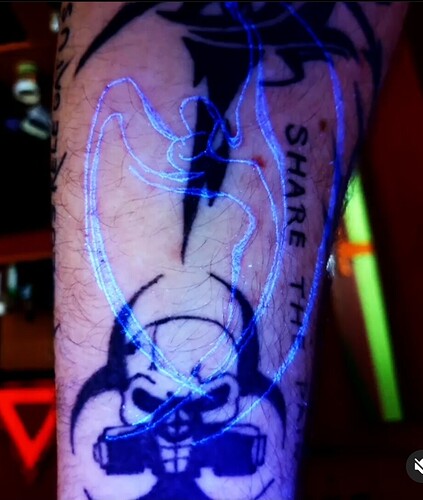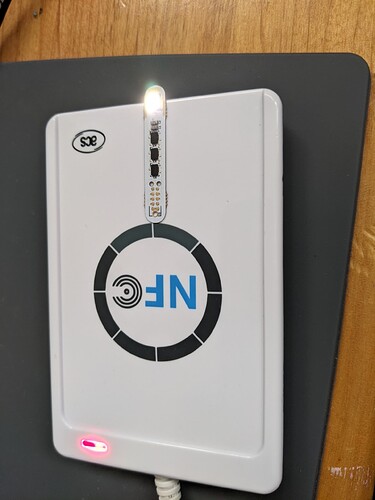So would a UV led on an implant be something feasible for production? In theory you could put on below a UV-ink tattoo to make it light up when powered. Would the UV be able to get far enough through the skin? Would it cause any issues with blasting high-intensity UV into the skin from the inside? If the other things wouldn’t be an issue, it would be really cool to see something like a UV litAF to light up a large area if diffused under the skin.
I have a few uv tattoos and tested ino from different companies and It’s not worth it because the effect disappears after 2 weeks
Isn’t melanin a UV ink? I mean if you desperately want a UV tattoo, all you gotta go is cut out a cardboard stencil and go sunbathe for a couple hours.
Of course, the refresh rate isn’t great…
Several problems:
-
UV rays cause cancer. One of the skin’s job is to capture a bit of it to generate vitamin D, and block the rest of it - the ratio of which is controlled by tanning. If you shine UV light from the inside, you bypass the only defense mechanism the body has against those radiations.
-
UV rays only travel a very short distance through flesh. It probably won’t reach the UV-sensitive particles in the UV ink at the very surface of the skin.
-
No safe way to provide power to the LED.
These look awesome though
Semi real answer,
Leds suck down a lot of power, and I think the UV leds were even worse
I think Amal tried a uv led with a bunch glow powder,
But maybe it was just blue
The light doesn’t diffuse very far either, like, maybe a 1/4” at best in either direction…
not much point
While I totally agree on the cancer-problem, I think this one here is absolutely possible. My nightglow implant sits below my skin (maybe deeper than a glassie would) and is powered from outside my body, so it’s the same distance like something inside powering something in the upper skin layers, or am I wrong here? I can even easily charge it with an UV-flashlight, so the rays travel deep enough.
Still think it’s a bad idea because of cancer, and because many, many (…most) UV tattoos don’t really last long. I even talked about that with Arnulf last week, and while he loves the idea of making my scars glow as well, he says there is no really reliable way to do so - at least not currently. And tattoo inks are a difficult topic in the EU anyways, they’re currently banning some pigments and preservatives…
Your nightglow implant is fluorescent, not glow-in-the-dark. As such, it contains some variant of fluorescein, which can charge up using visible light - specifically at 494 nm peak according to the Wikipedia article, which is blue/green and penetrates the skin fairly easily, as demonstrated by those implantees who wear blue or green blinkies.
The UV wavelength closest to the visible spectrum (UVA) will make it through the skin, albeit with considerable attenuation:
So basically assuming you have a UV LED under your skin, most of the radiation is used for cancer-making, and a tiny portion might light up your tattoo.
If I’m not totally wrong, fluorescence ends when the light is off, while phosphorescence keeps on glowing afterwards - my implant is, by this definition, phosphorescent. It charges up by day and keeps glowing by night. UV colours glow when they are exposed to UV light, and stop glowing in the moment the UV-lightsource is gone.
So yeah, there is some difference, and my implant is charged by visible light - but I can charge it with a UV lamp as well, and that’s just my point ![]() So the UV light definitely passes my skin and charges up my glowy.
So the UV light definitely passes my skin and charges up my glowy.
Still agree that it’s not a good idea, but it should be at least technically possible ![]()
Yes you’re correct. I’m very confused ![]()
NFC exists…
Like i2c power harvesting not a battery
I did some research when I was placing the purple LEDs on the Mega prototypes (which were 395nm). Above 380nm (long UV-A) has no carcinogenic effect, and even 365nm is negligible. Below 365nm and you’re asking for trouble though. “Blacklights” as they’re often called are around 365nm. They can penetrate the skin and most “UV” lights that are made to light up florescent dyes and charge phosphorescent powders are at that wavelength.
The true problem with UV LEDs is their forward voltage. They require 3.5-7V depending on the technology. Current energy harvesting chips just don’t go that high, so the LEDs won’t light. That, coupled with the volatile nature of UV tattoo ink makes this idea untenable.
We could do something with a normal white light with high intensity, embedded in a Silicone subdermal that has been doped with glow powder. That’s Miana’s plan with the flexLight. We’ll see if Haworth has any interest.
I’m going on several years and mine still glow like day 1
I envy you
oh sweet first time seeing the Mega prototype, will it have colored LEDs? and is it just 1 LED or will there be one on each end?
That knowledge is one of those little extra perks we get for being in the club.
Some behind-the-scenes info. Definitely worth it.
Not to say you won’t find out in due time, but there are pictures and videos “in the club” that will answer your question for you now
That isn’t the mega prototype in the pic, that’s the litAF flexLight
ohhhh, we’ll definitely excited for both them haha
Yeah no shit. The saucy Amal photoset alone is worth it.
Have you seen the special Christmas one, where he is dressed as Santa and is unwrapping his “present”? Best one yet!



